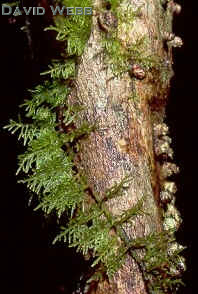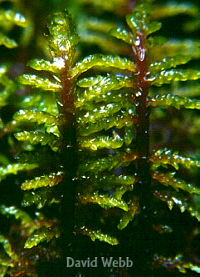
The next step in Evolution was a quest to become Vertical. Plants that could grow above Thalloid organisms would have a distinct adaptive advantage as they could intercept light and shade out their competitors. This requires the production of strengthening tissues and conducting tissues.
The Mosses
(Bryophyta) are the first group to
develop leafy, vertical shoots. They use the same strengthening and conducting tissues
that were found in the Liverworts but they produce them in sufficient quantities to
achieve verticality. These are still small plants which rarely top 10 cm.
group to
develop leafy, vertical shoots. They use the same strengthening and conducting tissues
that were found in the Liverworts but they produce them in sufficient quantities to
achieve verticality. These are still small plants which rarely top 10 cm.
The most complex species had photosynthetic and subterranean stems. The latter are root-like and produce Rhizoids.
These are still Small Plants reaching only a  few cm in height but
they tower over the Hepatophyta & Anthocerophyta.
few cm in height but
they tower over the Hepatophyta & Anthocerophyta.
Many species are terrestrial but a significant number are epiphytes. They typically grow in wet areas but some can grow in extremely cold and dry environments where they are Pioneers.
They can have minute Leaves but some species have comparatively complex leaves which have a Nerve which has conducting & strengthening tissues.